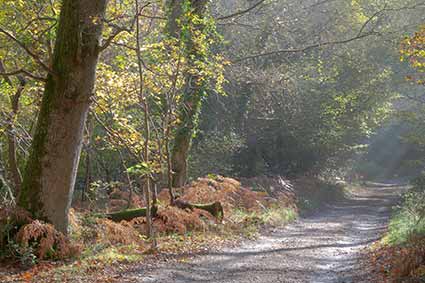Roydon Woods

Roydon Woods are situated to the south-east of Brockenhurst; just outside the perambulation of the New Forest.
Roydon Woods are a Hampshire and Isle of Wight Wildlife Trust nature reserve that extends to 950 acres. They are designated a Site of Special Scientific Interest (SSSI).
Ancient trees, including many fine beeches and oaks, adorn the path-sides, whilst there are also areas of younger broadleaved growth, patches of conifers, heathlands and grasslands. Enormous moss-clad wood-banks mark long-forgotten boundaries, ferns crowd over the woodland floor, and tiny streams tumble downhill, eventually to join the Lymington River.
Roydon Woods reserve is home to a wide range of wild flowers – over 350 species have been recorded - including spectacular carpets of spring-time bluebells. More than 120 lichen species have been identified, and amongst them are some real rarities; whilst 900 species of fungi have been seen.
Look out, too, in Roydon Woods from April to October for speckled wood butterflies dancing territorially in patches of sunlight; silver-washed fritillaries gorging on July bramble blossom nectar; rare, small pearl-bordered fritillaries; and many more beautiful butterflies.
Listen also for raucous jays, declaring presence, or displeasure, with typically harsh screeches. Great spotted, lesser spotted and green woodpeckers can also be seen, whilst nuthatches, marsh tits, tawny owls, woodcocks, nightjars and a host of other birds are also present, either as residents or seasonal visitors from abroad.
Roe deer, sika deer and fallow deer, too, live in Roydon Woods, sometimes conspicuously so, particularly during the autumnal sika and fallow deer ruts. Foxes prowl at dusk; and badgers use setts that sometimes are as old as the trees themselves, but these fascinating creatures are rarely seen during daylight hours.
Wild animal field signs are, however, usually visible in Roydon Woods. Budding nature detectives should look out for narrow tracks and paths cut through the vegetation; for deer, fox and badger droppings and passing places; for hair snagged on fences where the creatures have gone through; and for collections of feathers that betray sparrowhawk plucking posts.
When visiting Roydon Woods, though, please keep dogs under control at all times, and be aware that they are not allowed on part of the heathland in spring and early summer so as to avoid disturbing ground nesting birds and because cattle with calves are likely to be present.
Quick linksMore links
Other related links
Search this site

Sadly, 58 animals were killed - 35 ponies, 13 cows, 8 donkeys and 2 sheep, whilst a further 32 were injured - 3 pigs, 9 donkeys, 11 cows and 9 ponies.
(Forty-three accidents occurred in daylight, 15 at twilight and 101 in the dark. Twenty-seven accidents were not reported by the driver involved).
Here's just one horrific example - Three donkeys killed in collision with van at notorious New Forest blackspot (Advertiser and Times)

